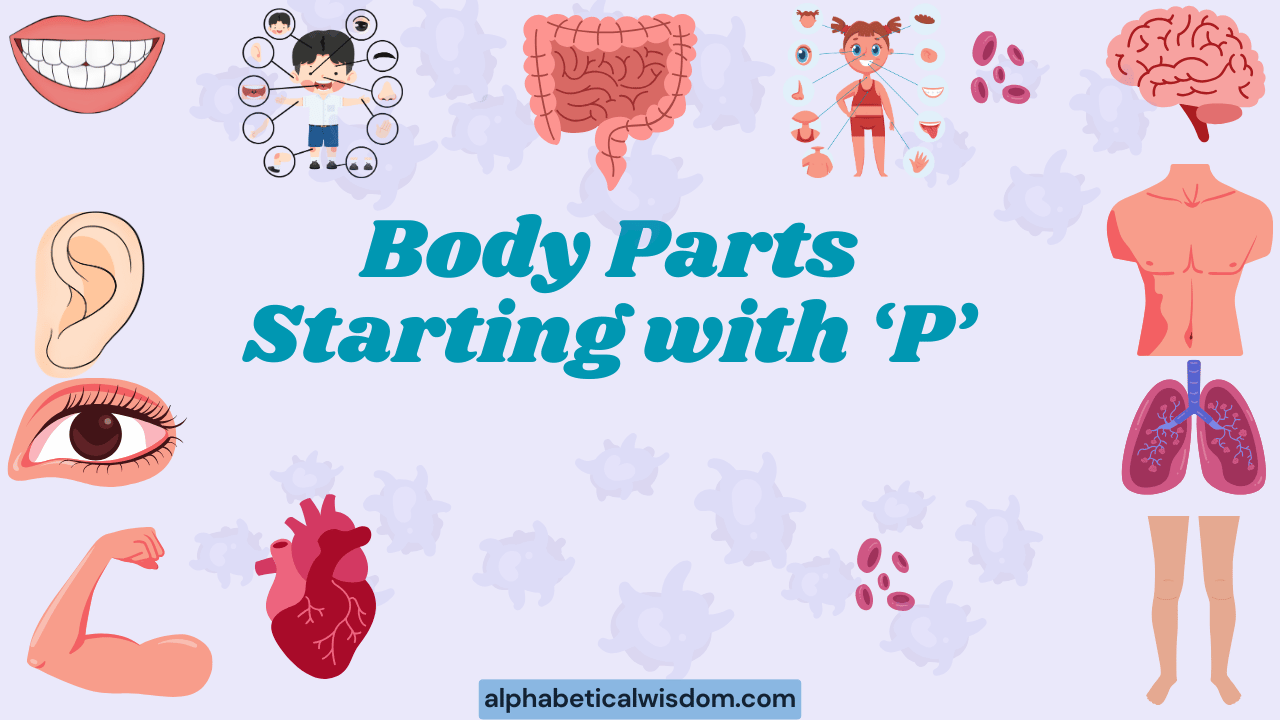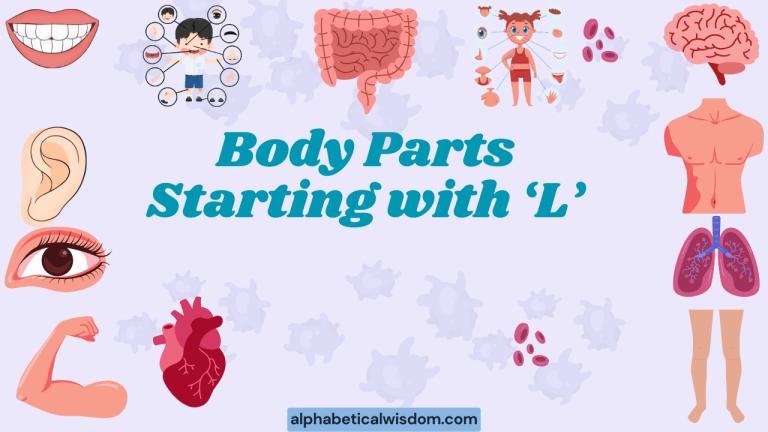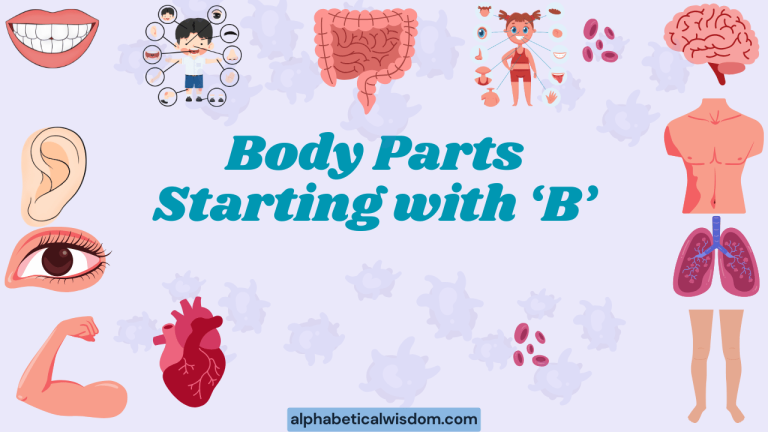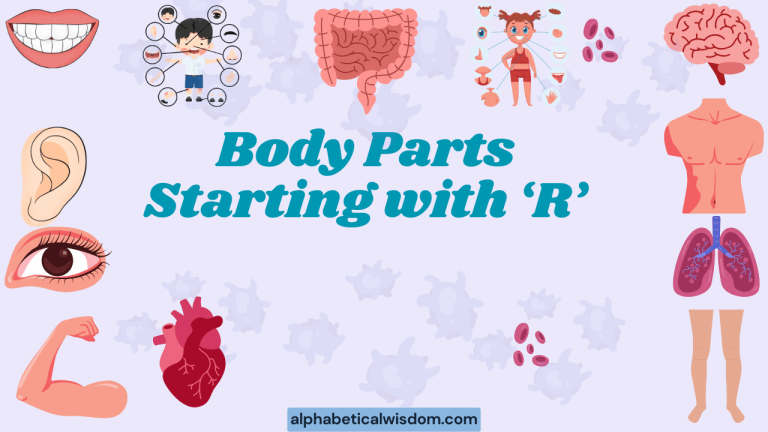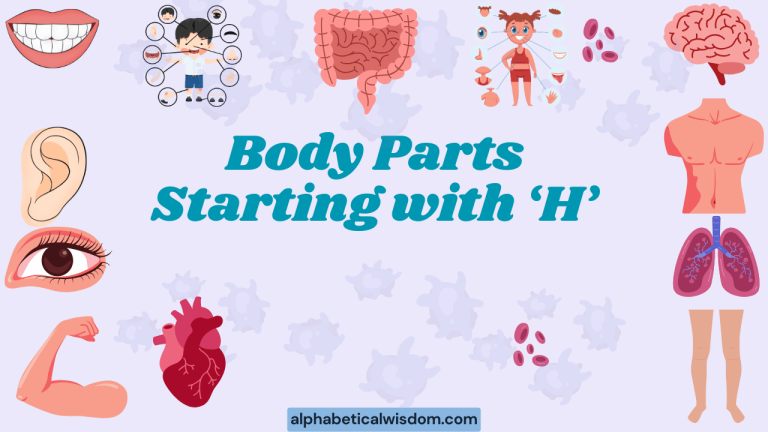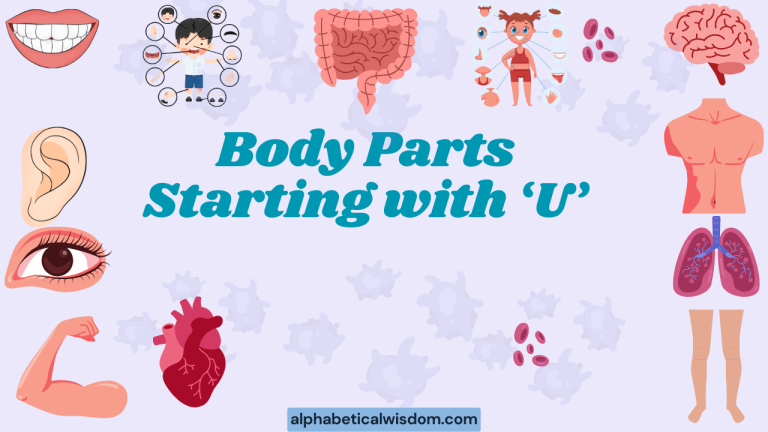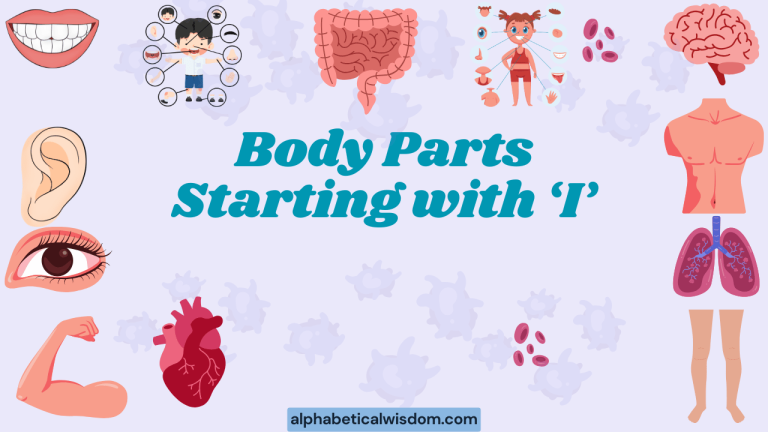Body Parts Starting with P: A Grammatical Deep Dive
Understanding the vocabulary of body parts is fundamental to English language proficiency. Specifically, mastering nouns that denote body parts beginning with the letter ‘P’ enhances both comprehension and expression.
This article provides a comprehensive exploration of these terms, delving into their definitions, grammatical roles, usage, and common pitfalls. Whether you are a beginning English language learner or an advanced speaker seeking to refine your knowledge, this guide will empower you with the vocabulary and grammatical awareness necessary for confident communication.
This thorough examination includes numerous examples, practical exercises, and helpful tips to ensure a complete understanding of this specific area of English vocabulary.
By focusing on this subset of vocabulary, learners can improve their precision and fluency when discussing health, anatomy, and general physical descriptions. The ability to accurately name and describe body parts is crucial in various contexts, from medical settings to everyday conversations.
This article will equip you with the necessary tools to confidently navigate these situations.
Table of Contents
- Introduction
- Definition of Body Parts Starting with ‘P’
- Structural Breakdown
- Types and Categories
- Examples
- Usage Rules
- Common Mistakes
- Practice Exercises
- Advanced Topics
- FAQ
- Conclusion
Definition of Body Parts Starting with ‘P’
This section defines body parts whose names begin with the letter ‘P’. These terms are primarily nouns and refer to specific anatomical structures.
Understanding their precise definitions is crucial for accurate communication, especially in medical, biological, and general conversational contexts. The following body parts will be discussed: palm, palate, pancreas, papilla, patella, pectoral, pelvis, penis, phalanx, pharynx, pineal gland, pituitary gland, placenta, plasma, pleura, pons, prostate, pupil.
Each of these words has a specific meaning and usage in the English language.
A noun is a word that names a person, place, thing, or idea. In this case, the ‘P’ words we’re focusing on all name specific parts of the human (or animal) body. They function as subjects, objects, or complements within sentences, providing essential information about the physical anatomy being discussed.
Structural Breakdown
The structural breakdown of these words primarily involves understanding their morphological composition and how they fit within sentences. Morphologically, some words are simple (e.g., palm), while others are complex and may have Greek or Latin roots (e.g., pharynx).
Syntactically, they function as nouns, taking articles (a, an, the), adjectives, and other modifiers.
For instance, consider the word “pancreas.” It’s a singular noun that can be modified by adjectives (e.g., “the inflamed pancreas”) or used as the subject or object of a verb (e.g., “The pancreas secretes insulin”). Understanding these structural roles is essential for constructing grammatically correct sentences.
Another example is “patella.” This word, referring to the kneecap, can appear in phrases like “a fractured patella” or sentences such as “The doctor examined the patient’s patella.” Recognizing the noun’s function within the sentence structure is key to proper usage.
Types and Categories
Body parts starting with ‘P’ can be categorized based on their location (external vs. internal) and function (e.g., digestive, skeletal, reproductive). This categorization helps in understanding their roles within the body and their appropriate use in different contexts.
External Body Parts
External body parts are those visible on the surface of the body. Examples include the palm (the inner surface of the hand), the patella (kneecap), and the pectoral (chest) muscles. These parts are often involved in physical interactions and are easily observable.
The palm, for example, is crucial for grasping and feeling. The patella protects the knee joint and aids in movement.
The pectoral muscles contribute to upper body strength and movement. Understanding these functions helps in using the terms correctly.
Internal Body Parts
Internal body parts are located inside the body and are not directly visible. Examples include the pancreas (an organ that produces insulin and digestive enzymes), the pharynx (the throat), the pineal gland (a gland that produces melatonin), the pituitary gland (a gland that controls many bodily functions), the placenta (an organ that develops in the uterus during pregnancy), the plasma (the liquid component of blood), the pleura (the lining of the lungs), the pons (part of the brainstem), the prostate (a gland in the male reproductive system), and the pupil (the opening in the center of the iris of the eye).
These internal organs and structures play vital roles in maintaining bodily functions. For instance, the pancreas regulates blood sugar, the pharynx facilitates swallowing, and the pituitary gland controls hormone secretion.
Knowing these functions is essential for accurate and informed communication about health and medicine.
Examples
This section provides extensive examples of how body parts starting with ‘P’ are used in sentences. These examples are categorized to illustrate different contexts and usages, including general, medical, idiomatic, and descriptive.
General Examples
These examples showcase the everyday use of these terms in common conversations. They illustrate how these words fit into various sentence structures and provide context for their meanings.
The following table presents a variety of examples using body parts starting with “P” in general contexts. These examples are designed to show how the words are naturally integrated into everyday language.
| Example Sentence | Body Part |
|---|---|
| He held the bird gently in the palm of his hand. | Palm |
| The doctor examined the child’s palate for any abnormalities. | Palate |
| The patient’s pancreas was functioning normally after the surgery. | Pancreas |
| The taste buds on the papillae of his tongue were very sensitive. | Papilla |
| She injured her patella while skiing. | Patella |
| He worked hard to build his pectoral muscles. | Pectoral |
| The accident caused a fracture in his pelvis. | Pelvis |
| The doctor explained the function of the penis to the young patient. | Penis |
| He broke a phalanx in his toe while playing soccer. | Phalanx |
| The pharynx is an important part of the respiratory system. | Pharynx |
| The pineal gland regulates sleep patterns. | Pineal gland |
| The pituitary gland controls hormone levels in the body. | Pituitary gland |
| The placenta provides nutrients to the developing fetus. | Placenta |
| The blood sample was centrifuged to separate the plasma. | Plasma |
| The pleura protects the lungs. | Pleura |
| The pons is a crucial part of the brainstem. | Pons |
| The doctor examined the patient’s prostate. | Prostate |
| Her pupils dilated in the dim light. | Pupils |
| He felt the smooth texture with the palm of his hand. | Palm |
| The surgeon repaired the cleft palate. | Palate |
| The doctor suspected a problem with his pancreas. | Pancreas |
| The enlarged papilla was a cause for concern. | Papilla |
| She needed surgery to repair her dislocated patella. | Patella |
| The bodybuilder focused on developing his pectoral muscles. | Pectoral |
| The fall resulted in a fractured pelvis. | Pelvis |
Medical Context Examples
These examples demonstrate the use of these terms in medical and scientific contexts. They highlight the importance of precise language when discussing anatomy, physiology, and medical conditions.
The table below provides examples of how body parts starting with “P” are used in medical and scientific contexts. These examples demonstrate the precision required in medical terminology.
| Example Sentence | Body Part |
|---|---|
| Palmar erythema can be a sign of liver disease. | Palm |
| A cleft palate can be corrected with surgery. | Palate |
| Pancreatitis is an inflammation of the pancreas. | Pancreas |
| The filiform papillae give the tongue its rough texture. | Papilla |
| A patellar fracture requires immediate medical attention. | Patella |
| The pectoralis major muscle is located in the chest. | Pectoral |
| A pelvic fracture can cause significant pain. | Pelvis |
| Hypospadias is a condition affecting the penis. | Penis |
| A fractured phalanx in the foot is a common sports injury. | Phalanx |
| Pharyngitis is an inflammation of the pharynx. | Pharynx |
| The pineal gland secretes melatonin. | Pineal gland |
| The pituitary gland is often called the master gland. | Pituitary gland |
| Placental abruption is a serious pregnancy complication. | Placenta |
| Plasma transfusions can be life-saving. | Plasma |
| Pleurisy is an inflammation of the pleura. | Pleura |
| The pons connects the cerebrum and the cerebellum. | Pons |
| Prostate cancer is a common concern for older men. | Prostate |
| Mydriasis is the dilation of the pupil. | Pupil |
| Palpation of the abdomen revealed an enlarged liver. | Palm |
| A high-arched palate can affect speech. | Palate |
| An MRI revealed a cyst on the pancreas. | Pancreas |
| The circumvallate papillae are located at the back of the tongue. | Papilla |
| Chondromalacia patellae is a common cause of knee pain. | Patella |
| The pectoralis minor muscle assists in shoulder movement. | Pectoral |
| Pelvic inflammatory disease can lead to infertility. | Pelvis |
Idiomatic Expressions Examples
Idiomatic expressions often use body parts metaphorically. Understanding these expressions requires knowledge of both the literal meaning of the words and their figurative usage.
This section provides examples of common idioms involving body parts starting with ‘P’.
The following table illustrates the idiomatic use of body parts beginning with “P.” These examples highlight how these words can take on figurative meanings in common expressions.
| Example Sentence | Body Part | Meaning |
|---|---|---|
| He had her eating out of the palm of his hand. | Palm | To be completely under someone’s control. |
| The news left a bad taste in my palate. | Palate | To leave one feeling displeased or offended. |
| She has eyes in the back of her head, you can’t pull the wool over her pupils. | Pupils | To be very perceptive and aware of everything happening around them. |
| He knows it like the palm of his hand. | Palm | To know something very well. |
| The idea was hard to palate at first. | Palate | To accept or tolerate something unpleasant. |
Descriptive Examples
These examples illustrate how body parts starting with ‘P’ can be used in descriptive writing to create vivid images and convey specific details about a person’s appearance or physical condition.
The table below provides examples of how body parts starting with “P” can be used in descriptive writing. These sentences aim to create vivid images and convey specific details.
| Example Sentence | Body Part |
|---|---|
| Her wrinkled palms told a story of hard work and resilience. | Palm |
| His refined palate could distinguish between the subtle nuances of different wines. | Palate |
| The doctor noted the tenderness around the patient’s pancreas during the examination. | Pancreas |
| The child’s small papillae were visible on his bright pink tongue. | Papilla |
| The athlete’s strong legs were supported by healthy patellae. | Patella |
| His broad pectoral muscles strained against the fabric of his shirt. | Pectoral |
| The X-ray revealed a complex fracture of the pelvis. | Pelvis |
| His piercing gaze was intensified by his dilated pupils. | Pupils |
| The texture of her skin was smooth as the palm of her hand. | Palm |
| The chef had a sophisticated palate for fine dining. | Palate |
| The scan showed inflammation of the pancreas. | Pancreas |
| The surface of the tongue is covered in tiny papillae. | Papilla |
| The runner suffered a dislocated patella during the race. | Patella |
| His muscular pectorals were a result of intense training. | Pectoral |
| The impact caused severe damage to his pelvis. | Pelvis |
| Her wide pupils reflected the excitement in her eyes. | Pupils |
Usage Rules
Several rules govern the correct usage of body part nouns starting with ‘P’. These rules include subject-verb agreement, appropriate article usage (a, an, the), and proper contextual application.
Failure to adhere to these rules can result in grammatical errors and miscommunication.
Subject-verb agreement is crucial. For example, “The pancreas is an important organ” (singular) versus “The pectorals are well-developed” (plural). The verb must agree in number with the subject noun.
Article usage depends on the context. Use “the” when referring to a specific body part (e.g., “The doctor examined the patella”) and “a” or “an” when referring to a general instance (e.g., “He has a pain in his pharynx”).
Contextual application requires using the correct term for the specific body part being discussed. For instance, using “palate” when you mean “pharynx” would be incorrect and confusing.
Common Mistakes
Several common mistakes occur when using body part nouns starting with ‘P’. These include misspellings, incorrect article usage, and confusion between similar-sounding words.
Misspellings are frequent. For example, “pancrease” instead of “pancreas” or “phalange” instead of “phalanx.” Careful attention to spelling is essential.
Incorrect article usage can also lead to errors. For example, saying “Doctor examined patella” instead of “The doctor examined the patella.” The definite article “the” is needed when referring to a specific patella.
Confusion between similar-sounding words can also cause problems. For instance, confusing “palate” (the roof of the mouth) with “palette” (a board used for mixing paints). Understanding the distinct meanings of these words is crucial.
The table below shows some common mistakes made with body parts starting with “P,” along with the correct versions.
| Incorrect | Correct | Explanation |
|---|---|---|
| The docter examined pancrease. | The doctor examined the pancreas. | Misspelling and missing article. |
| She has a pain in palate. | She has a pain in her palate. | Missing possessive pronoun. |
| He broke phalange in his foot. | He broke a phalanx in his foot. | Misspelling and incorrect article. |
| The plama was tested. | The plasma was tested. | Misspelling |
| The pleura is inflammed. | The pleura is inflamed. | Misspelling |
| The pons are important. | The pons is important. | Incorrect subject-verb agreement. |
| The pupel dilated. | The pupil dilated. | Misspelling |
Practice Exercises
These practice exercises are designed to reinforce your understanding of body part nouns starting with ‘P’. They include fill-in-the-blanks, sentence completion, and error correction exercises.
Exercise 1: Fill in the Blanks
Complete the following sentences with the correct body part noun starting with ‘P’.
Complete the sentences below by filling in the blanks with appropriate body parts that begin with the letter “P”. Answers are provided in the table following the questions.
| Question | Answer |
|---|---|
| 1. The doctor checked the roof of my mouth, which is called the __________. | Palate |
| 2. Insulin is produced by the __________. | Pancreas |
| 3. She fractured her __________ while ice skating. | Patella |
| 4. The __________ muscles are often worked out in the gym. | Pectoral |
| 5. A fracture of the __________ can be very painful. | Pelvis |
| 6. The __________ is part of the male reproductive system. | Penis |
| 7. The __________ is also known as the throat. | Pharynx |
| 8. Melatonin is produced by the __________ gland. | Pineal |
| 9. The __________ gland controls many other glands in the body. | Pituitary |
| 10. The __________ provides nutrients to the fetus during pregnancy. | Placenta |
Exercise 2: Sentence Completion
Complete the following sentences with a phrase that correctly uses a body part noun starting with ‘P’.
Complete the sentences below using a phrase that correctly incorporates a body part starting with the letter “P”. Answers are provided in the table following the questions.
| Question | Answer |
|---|---|
| 1. The baby grasped the rattle tightly in his __________. | Palm |
| 2. After the accident, he had severe pain in his __________. | Pelvis |
| 3. The infection caused inflammation of her __________. | Pharynx |
| 4. The doctor examined the patient’s __________ for any signs of swelling. | Patella |
| 5. The athlete strained his __________ during the weightlifting competition. | Pectoral Muscles |
| 6. The blood test revealed abnormalities in his __________. | Plasma |
| 7. The ophthalmologist checked the dilation of her __________. | Pupils |
| 8. The surgeon removed a portion of the damaged __________. | Pancreas |
| 9. The dentist examined the child’s __________. | Palate |
| 10. He fractured a __________ in his hand during the fight. | Phalanx |
Exercise 3: Error Correction
Identify and correct the errors in the following sentences. Each sentence contains one error related to the use of body part nouns starting with ‘P’.
Identify and correct the errors in the sentences below, focusing on the correct use of body parts starting with the letter “P”. Answers are provided in the table following the questions.
| Incorrect Sentence | Corrected Sentence |
|---|---|
| 1. The docter examined the pancrease. | The doctor examined the pancreas. |
| 2. She has a pain in the palate. | She has a pain in her palate. |
| 3. He broke phalange in his foot. | He broke a phalanx in his foot. |
| 4. The plama was tested for antibodies. | The plasma was tested for antibodies. |
| 5. The pleura are inflamed due to the infection. | The pleura is inflamed due to the infection. |
| 6. The pons are a crucial part of the brainstem. | The pons is a crucial part of the brainstem. |
| 7. The pupel dilated in response to the light. | The pupil dilated in response to the light. |
| 8. The pain was located in the pelvic region. | The pain was located in the pelvis. |
| 9. He worked to build his pectoral muscles. | He worked to build his pectoral muscles. |
| 10. The papilla on the tongue were very sensitive. | The papillae on the tongue were very sensitive. |
Advanced Topics
For advanced learners, exploring the etymology of these words can provide a deeper understanding of their meanings and historical context. Many of these terms have Greek or Latin origins, reflecting the historical influence of these languages on medical and scientific terminology.
Understanding these origins can enhance vocabulary retention and comprehension.
Furthermore, exploring the clinical significance of these body parts can deepen your understanding. For example, studying the diseases and conditions that affect the pancreas, pharynx, or pituitary gland can provide valuable insights into human health and medicine.
This knowledge is particularly useful for those pursuing careers in healthcare or related fields.
Another advanced topic is the study of anatomical variations. While the basic structure of these body parts is consistent across individuals, there can be variations in size, shape, and location.
Understanding these variations is important for medical professionals and researchers.
FAQ
This section addresses frequently asked questions about body parts starting with ‘P’. These questions cover definitions, usage, and common points of confusion.
- What is the difference between the palate and the pharynx?
The palate is the roof of the mouth, separating the oral cavity from the nasal cavity. The pharynx, also known as the throat, is a passageway for air and food, connecting the nasal cavity and mouth to the larynx and esophagus.
- What is the function of the pancreas?
The pancreas is an organ that produces enzymes for digestion and hormones, including insulin, that regulate blood sugar levels. It plays a crucial role in both the digestive and endocrine systems.
- What is the patella, and what does it do?
The patella, also known as the kneecap, is a small bone located in front of the knee joint. It protects the knee and improves the leverage of the thigh muscles, aiding in movement.
- What are pectoral muscles?
Pectoral muscles are the muscles of the chest. The pectoralis major is the larger muscle, responsible for adduction, flexion, and internal rotation of the arm. The pectoralis minor is a smaller muscle that assists in shoulder movement.
- What is the pelvis?
The pelvis is a bony structure located at the base of the spine. It supports the upper body, protects the internal organs, and connects the legs to the torso.
- What is the role of the pineal gland?
The pineal gland is a small endocrine gland located in the brain. It produces melatonin, a hormone that regulates sleep patterns and circadian rhythms.
- What does the pituitary gland do?
The pituitary gland, often called the “master gland,” is an endocrine gland located at the base of the brain. It controls many bodily functions by secreting hormones that regulate other glands and organs.
- What is the function of plasma in the blood?
Plasma is the liquid component of blood, making up about 55% of its total volume. It carries blood cells, nutrients, hormones, and waste products throughout the body.
- What is the pleura and its function?
The pleura is a serous membrane that lines the lungs and the inner wall of the chest cavity. It protects the lungs and allows them to move smoothly during breathing.
- What is the pons?
The pons is a part of the brainstem located above the medulla oblongata and below the midbrain. It connects the cerebrum and the cerebellum and plays a role in regulating sleep, respiration, swallowing, bladder control, hearing, equilibrium, taste, eye movement, facial expressions, facial sensation, and posture.
- What is the prostate gland?
The prostate gland is a gland in the male reproductive system located below the bladder. It produces fluid that nourishes and protects sperm.
- What is the pupil of the eye?
The pupil is the opening in the center of the iris of the eye. It allows light to enter the eye and is controlled by muscles that regulate its size, adjusting to different light levels.
Conclusion
Mastering the vocabulary of body parts starting with the letter ‘P’ is an essential step in enhancing your English language skills. This article has provided a comprehensive overview of these terms, including their definitions, grammatical roles, usage rules, and common mistakes.
By studying the examples, completing the practice exercises, and reviewing the FAQs, you can significantly improve your understanding and application of these words.
Remember to pay attention to spelling, article usage, and contextual application. Practice using these terms in your writing and speaking to reinforce your knowledge.
With consistent effort, you will become more confident and proficient in using body part nouns starting with ‘P’ in various contexts. Continue to expand your vocabulary and explore advanced topics to further refine your language skills.
Finally, don’t hesitate to consult dictionaries and grammar resources whenever you encounter unfamiliar words or grammatical structures. Consistent learning and practice are key to achieving fluency and accuracy in English.
Good luck on your language learning journey!
